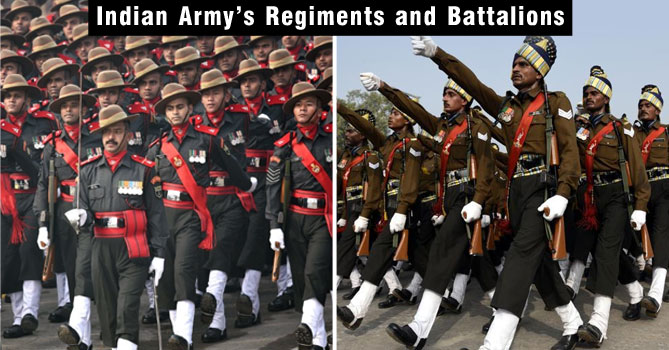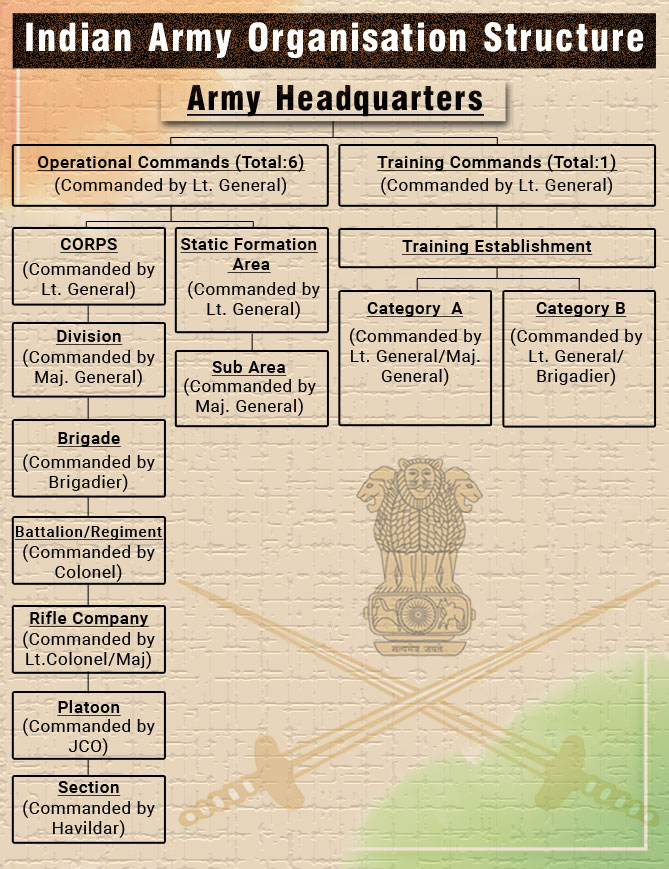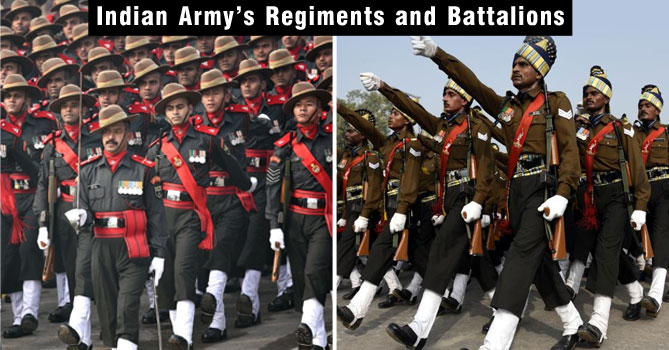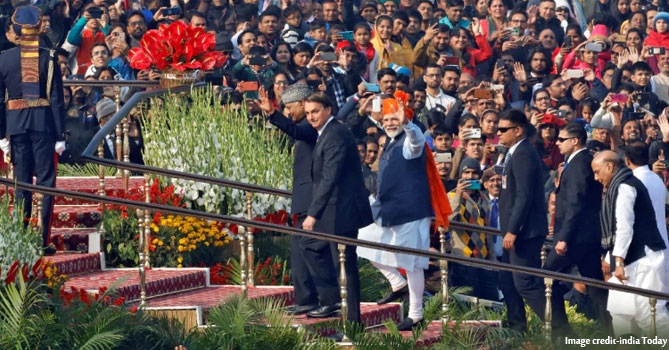
To understand the Regiments and Battalions of the Indian Army, one must understand the basic organizational structure and its formations.
The Indian Army is broadly classified into three groups:
Combat Arms (which includes the following)
– Infantry
– The Armoured Corp
– The Mechanized Infantry
– The Regiment of Artillery
– Corps of Army Air Defence
– Army Aviation Corps
Combat Support Arms (which includes the following)
– Corps of Engineers
– Corps of EME
– Corps of Signals
– Army Ordnance Corps
– Army Supply Corps
– Army Medical Corps
Supporting Arms (which includes the following)
– Intelligence Corps
– Corps of Military Police
– Territorial Army
– Judge Advocate General’s Department
– Remount and Veterinary Corps
– Army Education Corps
– Army Dental Corps
– Military Nursing Service
– Army Postal Service Corps
– Pioneer Corps
– Defence Security Corps
– Military Farms Services
Indian Army Organizational Hierarchy

Operational Command Formation
(Total: 6 Commands; each command comprised of Corps, which are fighting formations)
| Corps | Commanded by Lieutenant General; fighting composition comprising 3-4 Divisions |
| Division | Commanded by Maj General; comprising 3-4 Brigades |
| Brigade | Commanded by Brigadier; comprising 3 Battalions and Support Elements |
| Battalion/Regiment | Commanded by Colonel; consisting around 900 men divided into 4 Rifle Companies |
| Rifle Company | Commanded by Lieutenant Colonel / Major; comprising 3 Platoons |
| Platoon | Commanded by Junior Commissioned Officer (JCO); including 3 Sections |
| Section | Commanded by Havildar; involving ten men |
Seven Commands and their locations:
| Eastern Command | based at Kolkata |
| Western Command | based at Chandimandir |
| South Western Command | based at Jaipur |
| Northern Command | based at Udhampur |
| Southern Command | based at Pune |
| Central Command | based at Lucknow |
| Training Command | based at Shimla |
Origins of the Regiment
The origins of the Regiments of the Indian Army trace back to the colonial era under the British. The British needed to administer India and required locals to form a force under their command. They established Regiments on the lines of military history, race, and caste, giving each regiment a distinct identity by way of dress, tradition, ceremonies, and regimental pride.
One of the earliest Infantry Regiment formations before India’s independence in 1947 was the Madras Regiment in 1758. Followed by Punjab Regiment (1761), Maratha Light Infantry (1768), Rajputana Rifles (1775), Rajput Regiment (1778), The Grenadiers (1778), Kumaon Regiment (1813), 1 Gorkha Rifles (1815), 3 Gorkha Rifles (1815), 9 Gorkha Rifles (1817), Jammu & Kashmir Rifles (1821), 8 Gorkha Rifles (1824), Sikh Regiment (1846), 4 Gorkha Rifles (1857), 5 Gorkha Rifles (Frontier Force) (1858), Dogra Regiment (1877), Garhwal Rifles (1887), 11 Gorkha Rifles (1918-22; from 1948), Mahar Regiment (1941), Bihar Regiment (1941), Assam Regiment (1941), Sikh Light Infantry (1944), Parachute Regiment (1945), Jammu & Kashmir Light Infantry (1947).
Other Regiments formed post-independence include:
Brigade of the Guards (1948), Ladakh Scouts (1963), Naga Regiment (1970), Arunachal Scouts (2010), Sikkim Scouts (2013)
Regiments of the Infantry
- The Brigade of the Guards
- The Parachute Regiment
- The Rajputana Rifles
- The Punjab Regiment
- The Madras Regiment
- The Grenadiers
- The Sikh Light Infantry
- The Sikh Regiment
- The Dogra Regiment
- The Kumaon Regiment
- The Garhwal Rifles
- The Maratha Light Infantry
- The Gorkha Rifles
- The Jat Regiment
- The Rajput Regiment
- The Mahar Regiment
- The Bihar Regiment
- The Jammu & Kashmir Rifles
- The Jammu & Kashmir Light Infantry
- The Naga Regiment
- The Assam Rifles
- The Ladakh Scouts
- The Sikkim Scouts
- The Arunachal Scouts
- Rashtriya Rifles
- Other regiments include:
- Mechanized Infantry
- The Armoured Corp
- The Regiment of Artillery
- Army Air Defence
- Army Aviation Corps
- The Corps of Engineers
- The Corps of Signals
What is the difference between a Regiment and Battalion?
A Regiment is a fighting force formation which may comprise of smaller fighting units called Battalions. The regiments of the Indian Army’s Infantry include the Brigade of the Guards, Rajputana Rifles, Gorkha Rifles, Punjab Regiment, etc., as listed above.
The Armoured Corps, the Regiment of Artillery and others (refer list above) are also regiments which have several battalions forming part of them.
Each Regiment comprises battalions. For instance, in the case of Infantry Regiments, the Brigade of the Guards comprises battalions referred by number; for example, 16 Guards or 6 Guards. The number identifies the battalion while the name reflects the regiment to which it belongs.
In the case of the Gorkha Regiment, the structure is slightly different from the others. There are 7 Gorkha Regiments, six raised under the British, and one built post-independence.
There are 39 Gorkha battalions under the 7 Gorkha regiments. So, “6/5 Gorkha Rifles” would represent the 6th Battalion of 5 Gorkha Rifle Regiment.
The number of battalions in a regiment may vary. Each battalion comprises around 900 combat personnel headed by a Colonel rank officer.
An Infantry Battalion comprises 4 Rifle companies; each Rifle company comprises 3 Platoons; each Platoon comprises 3 Sections; each Section comprises 10 men.
What ‘Paltan ki Izzat’ means to a soldier?
When a soldier or an officer is commissioned into a battalion, it becomes his home and family for life, irrespective of where he may serve subsequently.
The soldier is explained, taught, and ingrained with the idea of ‘Paltan ki Izzat’ – a concept based on regimental values, sacrifice, honour, and tradition, all upheld by those before him – living or dead. The soldier trains to uphold the Paltan’s Izzat above all else, even his own life.
It is this ‘value’ that stands behind the heroic, and often, superhuman responses in battle, which make our Indian Army soldiers fearsome and highly respected across the world.
An Indian Army soldier loves his country and will defend it at any cost. However, it is Paltan ki Izzat which drives him to sacrifice his life for another fellow soldier and the country without fear or procrastination readily.
Paltan ki Izzat binds and holds the fighting unit as one large family and in the broader context, the nation.





